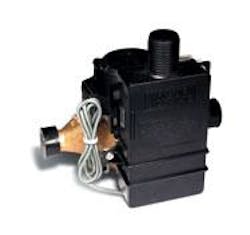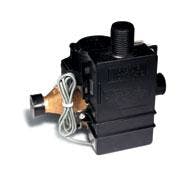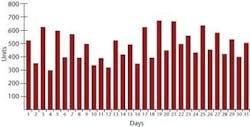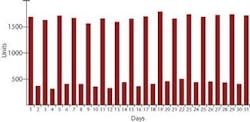AMR systems provide services beyond data collection
By Cory Dobbie, Scott Durham
Shrinking budgets, aging infrastructure and diminishing revenues are making efficient water utility management a critical need for municipalities worldwide.
Many water utilities are considering implementation of an Automated Meter Reading (AMR) system to reduce the cost of collecting and reading data from water meters throughout their area of service. Many utilities have already found that deploying AMR technology provides several additional benefits, such as enhanced system management, optimisation and improved customer service.
The city of McKinney, Texas, USA, recently realised the benefits of an AMR system. The city currently employs 26,000 water meters in a combination of suburban, city and rural areas. City officials decided to use AMR technology in 2000 in order to more efficiently manage their water distribution, reduce overhead costs and improve meter reading efficiency.
After evaluating several AMR system manufacturers, McKinney officials chose to install the Datamatic FIREFLY® AMR System. Of particular interest to officials was the FIREFLY's ProfilePLUS load profiling capability which archives hourly consumption patterns every 74 days. This tool provided the city with data previously unavailable, allowing officials to begin monitoring usage trends and patterns of each account.
"In addition to providing vital profiling information, AMR technology allow McKinney officials to address staffing concerns and reduce expenses by cutting the manpower and cost required to read meters," said Ken Kercher, chief executive officer of Datamatic, located in Plano, Texas, USA. "The system also allowed officials to focus resources on more pressing issues affecting McKinney residents such as system demand in various areas around the city."
Texas summers are typically hot and dry, and the summer of 2000 was no different. Consequently, large amounts of water were used to irrigate community lawn and garden landscaping.
Upon installation of Datamatic's AMR technology, McKinney Meter Reading Supervisor Cory Dobbie noticed that water meters in one section of town registered water consumption that did not equal the size of the area. He suspected that larger amounts of water were being used to maintain these lawns and gardens than the data that was being reported.
Upon physical inspection of the area, 5/8- x 3/4-inch meters were found on 1-inch services. At this time, FIREFLY ProfilePLUS data was examined on a sample meter (Figure 1). The ProfilePLUS indicated that during times when automatic sprinkler systems were operating the registered usage often approached or exceeded the meter's rated capacity. Further investigation revealed that many 1-inch service lines had been incorrectly reduced and that 5/8- x 3/4 -inch meters were being used where larger meters were necessary.
Dobbie feared that any usage that exceeded the meter's capacity was not being captured. "Meters rated for 20 gpm on lines that service a pull of 33 gpm can experience magnetic separation and will not catch all usage and may stop completely," said Dobbie. "The meter readers did not register any data during peak periods that grossly exceeded its maximum flow rate, which was confirmed by the meter manufacturer. As a result, many of the meters were not registering the correct water usage rates by customers with automatic sprinkler systems. This meant that potentially tens of thousands of gallons of water was being consumed at the cost of other city residents."
To confirm or banish their suspicions, Dobbie replaced a meter with a 1-inch unit designed to register expected flows for that service, along with a FIREFLY MIU. ProfilePLUS data was extracted for the next 30-day period from the new meter and officials predicted that the data would show usage that exceeded the rated capacity of the original meter.
Analysis showed that peaks on the ProfilePLUS graphs corresponded precisely with customer irrigation timer settings. Consumption averaged out to a flow of 20 to 32 gpm. This greatly exceeded the manufacturer's specification for the 5/8- x 3/4-inch meters, which measured a continuous flow of 15 gpm and a peak of 20 gpm. This initial data led the City to immediately install new meters on other suspect areas.
The final results of data accumulated during the pilot test from Datamatic's AMR technology were startling. One consumer was measured to have used 16,000 gallons in August, but that figure then surged to 93,000 gallons in September once the proper meter was installed. Data collected from another resident on the same street saw consumption jump from an average of 6,000 gallons a month to 77,000.
Data garnered from the ProfilePLUS technology proved that 5/8- x 3/4-inch meters were inadequate for these applications. Initially, it was thought the problem was small in scope since only the west side of the city was affected - mostly homes that were recently constructed. Further investigation indicated that approximately 8,000 meters were undersized and thousands of gallons of billable water were unmeasured each month. The problem had to be remedied quickly and cost effectively.
City officials were delighted about finding this large discrepancy, but they anticipated a public relations backlash from residents. Customers were startled to find their monthly water charges had dramatically increased, which led to questions about how a water bill could have jumped from US$ 45 to as much as US$ 250 a month.
City officials relied on ProfilePLUS data from the FIREFLY technology to show customers that their bills were accurate and justified. The McKinney Water Department distributed ProfilePLUS graphs to residents when needed, which encouraged water conservation. Virtually every customer reduced their usage in response to the higher bills (Figure 3). In addition, other residents were pleased to know they would no longer subsidise high-volume water users' bad habits.
A thorough, citywide resolution required a detailed analysis of the problem, research, project plan, estimated cost savings and all proposed project costs to the City Council for approval. The City Council immediately realized the value of the project and approved the changes.
It was equally important for the utility's staff to support the new program. "That was one of the reasons the city planned to use its own installation teams to change the affected sections as quickly as possible," said Dobbie. "The public was notified two weeks prior to any work so they would know what to expect in their neighbourhood. It was important that everyone, from the City Council to the installation team and residents, embrace the new program."
Within only a few months, the program exceeded expectations. The city government was pleased with the outcome of the study. The FIREFLY AMR system saved nearly US $222,000 a month and US$ 2.5 million a year in previously lost revenues. The full benefit of implementing the City's AMR system is still being researched; however it has become a key management tool used for the following:
• Dispute Resolution - McKinney uses profile data to resolve customer disputes by providing daily data to customers.
• Leak Detection - Profile data has the potential to indicate a leak within the system. The attached profile (See Appendix A, Figure 3) shows an approximated 40-gallon per hour leak. On 7 March 2003, the leak was repaired between 3 pm and 5 pm. The city used this capability many times to identify leaks and to explain the bill to a customer. In one case, a resident complained that a bill was excessive due to a leak. The city reviewed the data and notified the resident the precise day and time the leak was corrected. The resident acknowledged this by responding, "You're right, how did you know that?" at which time he agreed to pay the bill.
• Conservation Monitoring - Measures such as odd/even watering days are easily monitored using daily profile data. Enforcement now has a tool to verify compliance with city regulations.
• Regulation Enforcement - A very large commercial food-processing customer was suspected of improperly flushing grease and contaminants into the city sewage system. Profile data was extracted to evaluate water usage patterns. It was found that great amounts of water were periodically being used late at night when the location was supposed to be closed. Upon showing this date to the customer, the activity stopped. It should be noted that in this case, the data recorded 15-minute intervals for greater resolution and to better measure peak flow rates.
• Documenting Proper Meter Deployment - Profile data had been used to document proper installation of commercial meters. The City wanted to verify that meters were not exceeding rated register capacity. The ProfilePLUS interval on the FIREFLY unit can be adjusted down as low as one minute. This allows a minute-by-minute review of peak and flows through the meter. The importance of this capability has been highlighted during warranty disputes with meter manufacturers.
Authors' NoteCory Dobbie is a meter reading supervisor for the City of McKinney, Texas, USA. Scott Durham, the vice president of sales and marketing for Datamatic Ltd, can be reached at [email protected]. Additional information about Datamatic AMR systems and products is available at www.datamatic.com or by calling (800) 880-2878.



